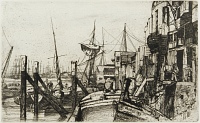Etchings Institutions search term: grolier club
Limehouse | ||
| Number: | 48 | |
| Date: | 1859 | |
| Medium: | etching and drypoint | |
| Size: | 128 x 204 mm | |
| Signed: | 'Whistler' at lower right | |
| Inscribed: | '1859' at lower right | |
| Set/Publication: | 'Thames Set', 1871 | |
| No. of States: | 6 | |
| Known impressions: | 82 | |
| Catalogues: | K.40; M.39; T.39; W.37 | |
| Impressions taken from this plate (82) | ||
KEYWORD
TITLE
'Curtis Gin' (1861, V&A). 1
'The Thames near Limehouse' (1861, R.A.). 2
'Limehouse' (1863, Whistler). 3
'Vue des bords de la Tamise' (1863, Salon). 4
'Limehouse' (1871, Ellis & Green). 5
'Limehouse' (1874, Ralph Thomas, Jr (1840-1876)). 6
'Limehouse, on the Thames' (1881, Union League Club). 7
The earliest titles, 'Curtis Gin' (taken from a signboard on a warehouse at right) and 'The Thames near Limehouse' are not certainly Whistler's; the first may have been suggested by Francis Seymour Haden, Sr (1818-1910) when he sold the etching, and the second is a descriptive title, possibly suggested by an exhibition organiser at the R.A..
Whistler's preferred title was 'Limehouse'; it was published in the 'Thames Set' under this title, and this was accepted by the majority of later cataloguers.
1: V&A Register of Prints, p. 32.
2: London RA 1861 (cat. no. 975).
3: Whistler to W. H. Carpenter, 3 August 1863, GUW #11109.
4: Paris S-d-Refusés 1863 (cat. no. 2756)
5: A Series of Sixteen Etchings of Scenes on The Thames .
6: Thomas 1874 (cat. no. 39).
7: New York 1881 (cat. no. 55).
DESCRIPTION
SITE
8: J. G. Birch, Limehouse through five centuries, London, 1930. p. 98, house repr. f.p. 100.
Views include Percy Noel Boxer's 1910 etching Wharves at Limehouse, Charles Napier Hemy's painting, The Harbour master's house, Limehouse of 1901, and Joseph Smith's watercolour The Harbour Master's house, Limehouse, 1934. 10 Broadway Wharf was also painted by Hemy, etched by W. L. Wyllie and appeared in a Wills cigarette card of about 1900! 11
9: See The Grapes website at http://www.thegrapes.co.uk or try the bar menu.
10: Peter Marcan, Artists and the East End. A survey and catalogue of twentieth century artists representing the East End of London, High Wycombe, 1986, pp. 20, 21, 33, 59.
11: i.e. Hemy, The Limehouse Barge Builders and Limehouse Hole, 1870s. Thanks to Martin Hopkinson for exhaustive research on this site.
DISCUSSION
12: http://www.nmm.ac.uk / collections (accessed 2008).
13: V&A FA.249[O] at http://collections.vam.ac.uk (accessed 2012).
14: Samuel Scott , Bicentenary catalogue, Guildhall Art Gallery, 1972, cat. no. 39. Again, thanks to Martin Hopkinson for this reference.
